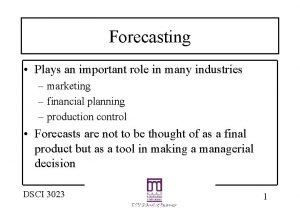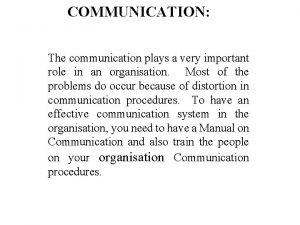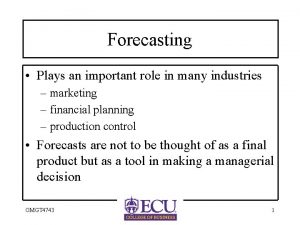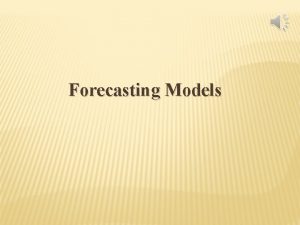Forecasting Plays an important role in many industries






















- Slides: 22

Forecasting • Plays an important role in many industries – marketing – financial planning – production control • Forecasts are not to be thought of as a final product but as a tool in making a managerial decision DSCI 3023 1

Forecasting • Forecasts can be obtained qualitatively or quantitatively • Qualitative forecasts are usually the result of an expert’s opinion and is referred to as a judgmental technique • Quantitative forecasts are usually the result of conventional statistical analysis DSCI 3023 2

Forecasting Components • Time Frame – long term forecasts – short term forecasts • Existence of patterns – seasonal trends – peak periods • Number of variables DSCI 3023 3

Patterns in Forecasts • Trend – A gradual long-term up or down movement of demand Upward Trend Demand Time DSCI 3023 4

Patterns in Forecasts • Cycle – An up and down repetitive movement in demand Cyclical Movement Demand Time DSCI 3023 5

Quantitative Techniques • Two widely used techniques – Time series analysis – Linear regression analysis • Time series analysis studies the numerical values a variable takes over a period of time • Linear regression analysis expresses the forecast variable as a mathematical function of other variables DSCI 3023 6

Time Series Analysis • • • Latest Period Method Moving Averages Example Problem Weighted Moving Averages Exponential Smoothing Example Problem DSCI 3023 7

Latest Period Method • Simplest method of forecasting • Use demand for current period to predict demand in the next period • e. g. , 100 units this week, forecast 100 units next week • If demand turned out to be only 90 units then the following weeks forecast will be 90 DSCI 3023 8

Moving Averages • Uses several values from the recent past to develop a forecast • Tends to dampen or smooth out the random increases and decreases of a latest period forecast • Good for stable demand with no pronounced behavioral patterns DSCI 3023 9

Moving Averages • Moving averages are computed for specific periods – Three months – Five months – The longer the moving average the smoother the forecast • Moving average formula DSCI 3023 10

Moving Averages - NASDAQ DSCI 3023 11

Weighted MA • Allows certain demands to be more or less important than a regular MA • Places relative weights on each of the period demands • Weighted MA is computed as such DSCI 3023 12

Weighted MA • Any desired weights can be assigned, but SWi=1 • Weighting recent demands higher allows the WMA to respond more quickly to demand changes • The simple MA is a special case of the WMA with all weights equal, Wi=1/n • The entire demand history is carried forward with each new computation • However, the equation can become burdensome DSCI 3023 13

Exponential Smoothing • Based on the idea that a new average can be computed from an old average and the most recent observed demand • e. g. , old average = 20, new demand = 24, then the new average will lie between 20 and 24 • Formally, DSCI 3023 14

Exponential Smoothing • Note: a must lie between 0. 0 and 1. 0 • Larger values of a allow the forecast to be more responsive to recent demand • Smaller values of a allow the forecast to respond more slowly and weights older data more • 0. 1 < a < 0. 3 is usually recommended DSCI 3023 15

Exponential Smoothing • The exponential smoothing form • Rearranged, this form is as such • This form indicates the new forecast is the old forecast plus a proportion of the error between the observed demand the old forecast DSCI 3023 16

Why Exponential Smoothing? • • • Continue with expansion of last expression As t>>0, we see (1 -a)t appear and <<1 The demand weights decrease exponentially All weights still add up to 1 Exponential smoothing is also a special form of the weighted MA, with the weights decreasing exponentially over time DSCI 3023 17

Forecast Error • Cumulative Sum of Forecast Error • Mean Square Error DSCI 3023 18

Forecast Error • Mean Absolute Error • Mean Absolute Percentage Error DSCI 3023 19

CFE • Referred to as the bias of the forecast • Ideally, the bias of a forecast would be zero • Positive errors would balance with the negative errors • However, sometimes forecasts are always low or always high (underestimate/overestimate) DSCI 3023 20

MSE and MAD • • Measurements of the variance in the forecast Both are widely used in forecasting Ease of use and understanding MSE tends to be used more and may be more familiar • Link to variance and SD in statistics DSCI 3023 21

MAPE • Normalizes the error calculations by computing percent error • Allows comparison of forecasts errors for different time series data • MAPE gives forecasters an accurate method of comparing errors • Magnitude of data set is negated DSCI 3023 22
 Forecasting plays an important role in
Forecasting plays an important role in Miracle and morality plays in english literature
Miracle and morality plays in english literature Moulding personality meaning
Moulding personality meaning Communication plays a very important role in
Communication plays a very important role in Importance of paralanguage
Importance of paralanguage Bulk gaining industries examples
Bulk gaining industries examples Deca role play examples
Deca role play examples Deca role plays
Deca role plays Dignity its essential role in resolving conflict
Dignity its essential role in resolving conflict Scenario
Scenario Describe the role competition plays in shaping communities.
Describe the role competition plays in shaping communities. Zero-base forecasting
Zero-base forecasting In many industries the market leaders
In many industries the market leaders From most important to least important in writing
From most important to least important in writing From most important to least important in writing
From most important to least important in writing Least important to most important
Least important to most important Web role in azure
Web role in azure Krappmann symbolischer interaktionismus
Krappmann symbolischer interaktionismus Statuses and their related roles determine
Statuses and their related roles determine Many sellers and many buyers
Many sellers and many buyers E r diagram
E r diagram Convert conceptual model to logical model
Convert conceptual model to logical model Erm vs erd
Erm vs erd











































